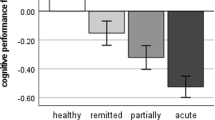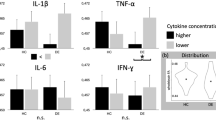Abstract
Purpose
Cushing’s syndrome (CS) is an endocrine disorder due to prolonged exposure to cortisol. Recently, microstructural white matter (WM) alterations detected by diffusion tensor imaging (DTI) have been reported in CS patients, and related to depression, but other functional significances. remain otherwise unclear. We aimed at investigating in more depth mood symptoms in CS patients, and how these relate to cognition (information processing speed), and to WM alterations on DTI.
Methods
The sample comprised 35 CS patients and 35 healthy controls. Beck Depression Inventory-II (BDI-II) was used to measure depressive symptoms, State-Trait Anxiety Inventory (STAI) to assess anxiety, and processing speed was measured by the Symbol Digit Modalities Test (SDMT). DTI studies were acquired using a 3-Tesla Philips-Achieva MR-facility. Voxelwise statistical analysis of fractional anisotropy (FA), mean, axial and radial diffusivities (MD, AD, RD) data were performed using FMRIB Software Library. Correlation analysis were obtained between mood and processing speed variables, and FA, MD, AD and RD values, taking both CS patients and healthy controls.
Results
Active, controlled and cured CS patients showed greater depression (F = 12.4, p < 0.001), anxious state (F = 4.8, p = 0.005) and anxious trait (F = 9.6, p < 0.001) scores, than controls. Using the entire sample, depression scores correlated negatively to FA and positively to RD values. Although there were no differences in processing speed between groups, SDMT scores correlated positively to both FA and AD values.
Conclusions
There were greater depressive and anxious symptoms in CS patients than in healthy controls, but no difference in processing speed. However, DTI is related to depression and information processing speed in CS.




Similar content being viewed by others
References
Bertagna X, Guignat L, Groussin L, Bertherat J (2009) Cushing’s disease. Best Pract Res Clin Endocrinol Metab 23(5):607–623
Hatipoglu BA (2012) Cushing’s syndrome. J Surg Oncol 106(5):565–571
Starr AM (1952) Personality changes in Cushing’s syndrome. J Clin Endocrinol Metab 12(5):502–505
Kelly WF (1996) Psychiatric aspects of Cushing’s syndrome. QJM 89(7):543–551
Loosen PT, Chambliss B, DeBold CR, Shelton R, Orth DN (1992) Psychiatric phenomenology in Cushing’s disease. Pharmacopsychiatry 25(4):192–198
Bourdeau I, Bard C, Forget H, Boulanger Y, Cohen H, Lacroix A (2005) Cognitive function and cerebral assessment in patients who have Cushing’s syndrome. Endocrinol metab clin N Am 34(2), 357–369
Andela CD, Van Haalen F, Ragnarsson O, Papakokkinou E, Johannsson G, Santos A, Webb S, Biermasz NR, van der Wee NJ, Pereira AM (2015) Mechanisms in endocrinology: Cushing’s syndrome causes irreversible effects on the human brain: a systematic review of structural and functional magnetic resonance imaging studies. Eur J Endocrinol 173(1):R1–R14
Budde MD, Xie M, Cross AH, Song SK (2009) Axial diffusivity is the primary correlate of axonal injury in the experimental autoimmune encephalomyelitis spinal cord: a quantitative pixelwise analysis. J Neurosci 29(9):2805–2813. doi:10.1523/JNEUROSCI.4605-08.2009
Alexander AL, Lee JE, Lazar M, Field AS (2007) Diffusion tensor imaging of the brain. Neurotherapeutics 4(3):316–329. doi:10.1016/j.nurt.2007.05.011
Pires P, Santos A, Vives-Gilabert Y, Webb SM, Sainz-Ruiz A, Resmini E, Crespo I, de Juan-Delago M, Gómez-Anson B (2015) White matter alterations in the brains of patients with active, remitted, and cured cushing syndrome: a DTI study. AJNR Am J Neuroradiol 36(6):1043–1048
van der Werff SJA, Andela CD, Nienke Pannekoek J, Meijer OC, van Buchem MA, Rombouts SARB, van der Mast RC, Biermasz NR, Pereira AM, van der Wee NJA (2014) Widespread reductions of white matter integrity in patients with long-term remission of Cushing’s disease. NeuroImage 4, 659–667. doi:10.1016/j.nicl.2014.01.017
Gutiérrez R, Boison D, Heinemann U, Stoffel W (1995) Decompaction of CNS myelin leads to a reduction of the conduction velocity of action potentials in optic nerve. Neurosci Lett 195(2):93–96
Hsu JL, Chen YL, Leu JG, Jaw FS, Lee CH, Tsai YF, Hsu CY, Bai CH, Leemans A (2012) Microstructural white matter abnormalities in type 2 diabetes mellitus: a diffusion tensor imaging study. Neuroimage 59(2):1098–1105. doi:10.1016/j.neuroimage.2011.09.041
Beck AT, Ward CH, Mendelson M, Mock J, Erbaugh J (1961) An inventory for measuring depression. Arch Gen Psychiatry 4:561–571
Smith A (1982) Symbol digit modalities test: manual. Western Psychological Services, Los Angeles
Smith SM, Jenkinson M, Woolrich MW, Beckmann CF, Behrens TEJ, Johansen-Berg H, Bannister PR, De Luca M, Drobnjak I, Flitney DE, Niazy RK, Saunders J, Vickers J, Zhang Y, De Stefano N, Brady JM, Matthews PM (2004) Advances in functional and structural MR image analysis and implementation as FSL. NeuroImage 23(Suppl 1):S208–219. doi:10.1016/j.neuroimage.2004.07.051
Smith SM (2002) Fast robust automated brain extraction. Hum Brain Mapp 17(3):143–155. doi:10.1002/hbm.10062
Smith SM, Jenkinson M, Johansen-Berg H, Rueckert D, Nichols TE, Mackay CE, Watkins KE, Ciccarelli O, Cader MZ, Matthews PM, Behrens TE (2006) Tract-based spatial statistics: voxelwise analysis of multi-subject diffusion data. Neuroimage 31:1487–1505
Smith SM, Nichols TE (2009) Threshold-free cluster enhancement: addressing problems of smoothing, threshold dependence and localisation in cluster inference. Neuroimage, 44(1), 83–98. doi:10.1016/j.neuroimage.2008.03.061
Sonino N (1997) From the lesson of Harvey Cushing to current knowledge: psychosocial aspects of endocrine disease. Psychother Psychosom 66:113–116
Sonino N, Fava GA (2001) Psychiatric disorders associated with Cushing’s syndrome. Epidemiology, pathophysiology and treatment. CNS Drugs 15:361–373
Sonino N, Fallo F, Fava GA (2010) Psychosomatic aspects of Cushing’s syndrome. Rev Endocr Metab Disord 11(2):95–104. doi:10.1007/s11154-009-9123-7
Starkman MN, Schteingart DE, Schork MA (1981) Depressed mood and other psychiatric manifestations of Cushing’s syndrome: relationship to hormone levels. Psychosom Med 43(1):3–18
Kelly WF, Kelly MJ, Faragher B (1996) A prospective study of psychiatric and psychological aspects of Cushing’s syndrome. Clin Endocrinol 45(6):715–720
Andela CD, Van Haalen F, Ragnarsson O, Papakokkinou E, Johannsson G, Santos A, Webb S, Biermasz NR, van der Wee NJ, Pereira AM (2015) Mechanisms in endocrinology: Cushing’s syndrome causes irreversible effects on the human brain: a systematic review of structural and functional magnetic resonance imaging studies. Eur J Endocrinol 173(1):R1–R14. doi:10.1530/EJE-14-1101
Sonino N, Navarrini C, Ruini C, Ottolini F, Paoletta A, Fallo F, Boscaro M, Fava GA (2004) Persistent psychological distress in patients treated for endocrine disease. Psychother Psychosom, 73(2):78–83. doi:10.1159/000075538
Sobrinho LG (2004) Psychopathology in endocrine disorders: why so persistent after the cure? Psychother Psychosom 73(2):65–67. doi:10.1159/000075536
Pereira, AM, Tiemensma J, Romijn JA (2010) Neuropsychiatric disorders in Cushing’s syndrome. Neuroendocrinology 92(Suppl 1):65–70. doi:10.1159/000314317
Heald AH, Ghosh S, Bray S, Gibson C, Anderson SG, Buckler H, Fowler HL (2004) Long-term negative impact on quality of life in patients with successfully treated Cushing’s disease. Clin Endocrinol:61(4):458–465. doi:10.1111/j.1365-2265.2004.02118.x
van der Klaauw AA, Kars M, Biermasz NR, Roelfsema F, Dekkers OM, Corssmit EP, van Aken MO, Havekes B, Pereira AM, Pijl H, Smit JW, Romijn JA (2008) Disease-specific impairments in quality of life during long-term follow-up of patients with different pituitary adenomas. Clin Endocrinol 69(5):775–784. doi:10.1111/j.1365-2265.2008.03288.x
Santos A, Crespo I, Aulinas A, Resmini E, Valassi E, Webb SM (2015) Quality of life in Cushing’s syndrome. Pituitary 18(2):195–200. doi:10.1007/s11102-015-0640-y
Song S-K, Yoshino J, Le TQ, Lin S-J, Sun S-W, Cross AH, Armstrong RC (2005) Demyelination increases radial diffusivity in corpus callosum of mouse brain. Neuroimage 26(1):132–140. doi:10.1016/j.neuroimage.2005.01.028
Fields RD (2008) White matter in learning, cognition and psychiatric disorders. Trends Neurosci 31(7):361–370. doi:10.1016/j.tins.2008.04.001
Sexton CE, Mackay CE, Ebmeier KP (2009) A systematic review of diffusion tensor imaging studies in affective disorders. Biol Psychiatry 66(9):814–823. doi:10.1016/j.biopsych.2009.05.024
Sexton CE, Allan CL, Le Masurier M, McDermott LM, Kalu UG, Herrmann LL, Mäurer M, Bradley KM, Mackay CE, Ebmeier KP (2012) Magnetic resonance imaging in late-life depression: multimodal examination of network disruption. Arch Gen Psychiatry 69(7):680–689. doi:10.1001/archgenpsychiatry.2011.1862
Mazet P, Simon D, Luton JP, Bricaire H (1981) Psychic symptoms and personality of 50 patients with Cushing’s syndrome (author’s transl). La Nouvelle Presse Médicale 10(31):2565–2570
Kim MJ, Whalen PJ (2009). The structural integrity of an amygdala-prefrontal pathway predicts trait anxiety. J Neurosc 29(37):11614–11618. doi:10.1523/JNEUROSCI.2335-09.2009
Ayling E, Aghajani M, Fouche J-P, van der Wee N (2012) Diffusion tensor imaging in anxiety disorders. Curr Psychiatry Rep 14(3):197–202. doi:10.1007/s11920-012-0273-z
Modi S, Trivedi R, Singh K, Kumar P, Rathore RKS, Tripathi RP, Khushu S (2013) Individual differences in trait anxiety are associated with white matter tract integrity in fornix and uncinate fasciculus: preliminary evidence from a DTI based tractography study. Behav Brain Res 238:188–192. doi:10.1016/j.bbr.2012.10.007
van den Heuvel DMJ, ten Dam VH, de Craen AJM, Admiraal-Behloul F, Olofsen H, Bollen, ELEM, Jolles J, Murray HM, Blauw GJ, Westendorp RG, van Buchem MA (2006) Increase in periventricular white matter hyperintensities parallels decline in mental processing speed in a non-demented elderly population. J Neurol Neurosurg Psych 77(2):149–153. doi:10.1136/jnnp.2005.070193
Borghesani PR, Madhyastha TM, Aylward EH, Reiter MA, Swarny BR, Schaie KW, Willis SL (2013) The association between higher order abilities, processing speed, and age are variably mediated by white matter integrity during typical aging. Neuropsychologia 51(8):1435–1444. doi:10.1016/j.neuropsychologia.2013.03.005
Jacobs HIL, Leritz EC, Williams VJ, Van Boxtel MPJ, van der Elst W, Jolles J, Verhey FR, MC Glinchey RE, Milberg WP, Salat DH (2013) Association between white matter microstructure, executive functions, and processing speed in older adults: the impact of vascular health. Hum Brain Mapp 34(1):77–95. doi:10.1002/hbm.21412
Bourdeau I, Bard C, Noël B, Leclerc I, Cordeau M-P, Bélair M, Lesage J, Lafontaine L, Lacroix A (2002) Loss of brain volume in endogenous Cushing’s syndrome and its reversibility after correction of hypercortisolism. J Clin Endocrinol Metab 87(5):1949–1954. doi:10.1210/jcem.87.5.8493
Resmini E, Santos A, Gómez-Anson B, Vives Y, Pires P, Crespo I, Portella MJ, de Juan-Delago M, Barahona MJ, Webb SM (2012) Verbal and visual memory performance and hippocampal volumes, measured by 3-Tesla magnetic resonance imaging, in patients with Cushing’s syndrome. J Clin Endocrinol Metab 97(2):663–671. doi:10.1210/jc.2011-2231
Santos A, Resmini E, Crespo I, Pires P, Vives-Gilabert Y, Granell E, Valassi E, Gómez-Ansón B, Martínez-Momblán MA, Mataró M, Webb SM (2014) Small cerebellar cortex volume in patients with active Cushing’s syndrome. Eur J Endocrinol 171(4):461–469. doi:10.1530/EJE-14-0371
Crespo I, Santos A, Gómez-Ansón B, López-Mourelo O, Pires P, Vives-Gilabert Y, Webb SM, Resmini E (2016) Brain metabolite abnormalities in ventromedial prefrontal cortex are related to duration of hypercortisolism and anxiety in patients with Cushing’s syndrome. Endocrine. doi:10.1007/s12020-016-0963-0
Kerchner GA, Racine CA, Hale S, Wilheim R, Laluz V, Miller BL, Kramer JH (2012) Cognitive processing speed in older adults: relationship with white matter integrity. PloS ONE 7(11):e50425. doi:10.1371/journal.pone.0050425
Acknowledgements
We want to thank patients and healthy volunteers who participated in the current study for their kind cooperation.
Funding
This project was supported by grants from ISCIII, Spanish Ministry of Science and Innovation (MICINN, FIS080302 and FIS 070770) and the European Commission (ERCUSYN PHP800200).
Author information
Authors and Affiliations
Corresponding author
Ethics declarations
Conflict of interest
Patricia Pires, Alicia Santos, Yolanda Vives-Gilabert, Susan Webb, Aitor Sainz-Ruiz, Eugenia Resmini declares, Iris Crespo, Manuel de Juan-Delago and Beatriz Gómez-Ansón declares that they have no conflict of interest.
Ethical approval
All procedures performed in studies involving human participants were in accordance with the ethical standards of the institutional and/or national research committee and with the 1964 Helsinki declaration and its later amendments or comparable ethical standards.
Research involving animal rights
This article does not contain any studies with animals performed by any of the authors.
Informed consent
Informed consent was obtained from all individual participants included in the study.
Rights and permissions
About this article
Cite this article
Pires, P., Santos, A., Vives-Gilabert, Y. et al. White matter involvement on DTI-MRI in Cushing’s syndrome relates to mood disturbances and processing speed: a case-control study. Pituitary 20, 340–348 (2017). https://doi.org/10.1007/s11102-017-0793-y
Published:
Issue Date:
DOI: https://doi.org/10.1007/s11102-017-0793-y




